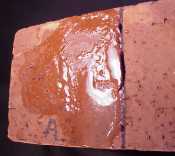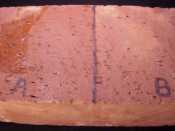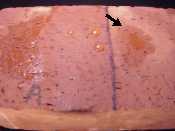

A strong stripper applied to part of the sealed half.

3 minutes later: wiped off and the sealer is removed.
The stripped side looks the same as the raw side.

They are not the same!
Note the water drops do not absorb into the stripped half,
but immediately absorb into the raw side at arrow.

After stripping, test the absorption range ........ Click here
Usually, problems are due to lack of information before starting the job. It really is a simple, satisfactory, and rewarding project with a little preparation.
Keep in mind:
The secondary goal is the appearance.
The primary goal is a problem free sealing job.
This is the reverse of the way a project is usually addressed. However, the pretty appearance will not be so important if the job needs to be redone in a year or less. Remember, you have to move furniture again. You will see how to achieve the appearance goals in other ways than just the sealer.
Before deciding how to proceed - evaluate the following criteria:
Do You Really Need To Strip The Old Sealer?
If the existing sealer is not well bonded to the surfacing, there is little point to putting anything on top of it. It will continue to lose bond over time and wear and peel from the surfacing. A good way to evaluate the quality of the existing sealer bonding is:The Old Sealer Has To Go, Now What?If there are already areas of peeling, it is reasonable to assume there will be others and the bonding overall is risky.
Use a piece of tape to see if you can lift the sealer from the surface. You should not be able to do this "forced peeling" if there is a good bond.
Choose a stripper from our suggestion list here. What if the surface had a color material applied before it was sealed? Will the stripping hurt the color?
It could! Therefore, you want to test a small out of the way area first. If that does happen, here are the options:If the old sealer is a water based coating type - test a wax stripper from the sealer preparation section here.
If the old sealer is a solvent base, you can drop many levels of aggressiveness of stripping by trying mineral spirits, then moving up to lacquer thinner
Choosing The New Sealer
Before stripping, identify the old sealer type per these tips so that you maintain compatibility as much as possible Click here
An option for tough situations where you really cannot figure out what was on the floor before!
When the known, or unknown, conditions have created a situation where sealer bonding is risky, we always suggest the use of a petroleum solvent based acrylic sealer. Sometimes you need to dilute it a bit per the manufacturer recommendations to lower the solids level to get good deep penetration and bonding.
ALWAYS - ALWAYS - ALWAYS - PATCH TEST FIRST!
If the tile had been sealed with an oil (linseed oil, motor oil, etc) and wax technique that was popular years ago - you need to consider the following:
There are still companies that supply tile they call "sealed", but the technique is to use oil to saturate the pore structure of the tile and support a subsequently applied film of wax. This is quite attractive, but does not last. The wax requires a high level of maintenance and the technique does not impart any of the other benefits to the flooring as do modern sealers.
You do not want to reseal with a water based sealer as it will not properly penetrate and/or bond - very high risk!
Resealing with a solvent base sealer may re-liquify the old, dried out oil and cause patchy discoloration ( see below ).
Therefore, you may want to stay with the wax and put up with the high maintenance requirements. However, if that is not an acceptable answer, then there is another option for you to test and evaluate. It is to use a sealer that indicates "color enhancement". These have a natural tendency to darken the tile a few shades. This darkening will tend to mask patches of discoloration if they occur.